Foreword: Attempt to define the Battlecruiser
-The first point is semantic: very name “battlecruisers” has been misleading ever since it was first coined in 1912. The idea of a nimble fast warship, the cruiser, did not rendered justice to its capital ship capabilities (less the protection), so it was coined after the “battleship”, the latter being replaced by the supposed lighter “cruiser” to try to evoke its fast and independent nature. Indeed, battlecruisers were both that, and superbly demonstrated this nature as being the most engaged (and sunk) capital ships of WW1, with the exception of pre-dreadnoughts engaged in Gallipoli.
-The second point is chronological: Battlecruisers historically disappeared after the treaty of Washington which did not had a place for them or did not distinguished between them and capital ships. They were placed in the same bag. This was the result of various experimentations in armour schemes and concepts of late war naval thinking (the result of detailed analysis of the battle of Jutland), which basically went to a kind of intermediate between “pure” battlecruisers and battleships, something which led to the design of the admiral class, of which only the Hood was built, and many interesting projects of 1919.
-The last point is nationalistic: Battlecruisers were built by two naval powers of the time, one being the leader, The Royal Navy, the second its new challenger, the Kaiserliche Marine. There was a clear arms race between the two fleets even before HMS Dreadnought was launched, and others fleets around the world tried to catch up, to the exception of Japan, so close to its model, four of them were quickly ordered.
In short, the battlecruiser was a battleship with a lighter armour (and better speed). The latter resulted less from a power increase, than from a more slender hull combined to a better power-to-weight ratio. The speed difference was not immense. Compared to the first Dreadnought (21 knots or 39 km/h, 24 mph), the HMS Invincible was just capable of 25 knots (46 km/h; 29 mph), a four knots difference. Her range was also way shorter, nearly half, and her armament reduced, and of course her armour way lighter. This could legitimately cause concerns about the value of a battlecruiser in a battleline as the name suggest. But its role was not the same. The dreadnought was still a battleship, made to form a battle line and pour shell on an enemy until it was doomed, while being able to take hits in returns. The Battlecruiser was more a “reconnaissance battleship”, able to scout for the fleet while being able to deal with any enemy advance, therefore her armour has only to be sufficient to deal with cruiser’s rounds, which were generally used as scouts as well.
Britain’s last armoured cruisers: Minotaur class (1906)
These cruisers were launched after HMS Dreadnought (Feb. 1906), so in June, September 1906 for HMS Minotaur and Shannon and even April 1907 for HMS Defence. As in other fleet, the construction of further ships of that category was suspended. Indeed, in February 1906, the same month Dreadnought was launched, the keel of HMS Inflexible was laid don at Clydebank Yard. Discussions went on well before, and the construction of the Nelson class (1905), the last pre-dreadnoughts, mirrored their corresponding cruisers, the Minotaur class. When they were laid down, the Dreadnought was merely seen as a prototype. Although not battlecruisers yet, they were already in arguably attached to a sub-class of “semi-battlecruisers”, due to their powerful secondary armament, on par with the similar evolution on the Nelson, classed afterwards as “semi-dreadnoughts”. However, contrary to the latter, speed was a factor, and engineer, to save her beam could not adopt twin turrets for the secondaries. Instead, they adopted single guns. But this was still formidable.
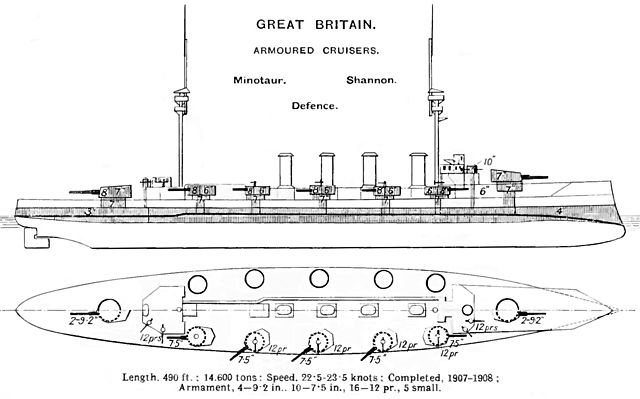
Let’s compare them to the Invincible class:
Armament-wise, the Minotaur had four BL 9.2-inch (234 mm) and no less than ten single BL 7.5-inch (191 mm) Mk V guns, a total of 14 guns, versus eight on the Invincible. Not only this was nearly double, the guns were also faster-firing, though, not to the same range… on paper. In reality as the numerous battles on the north sea shown, bad weather prevented ships to used their maximal range. It often went quite low in practice, and therefore, these armoured cruisers could engage other ships, and pour on them a multiple of fourteen 234 and 190 mm shells on target every minute, close to 2 rpm in practice for the first and 6 for the second. Since half the battery was on the other broadside it was up to 38 shells per minute while the Invincible’s class (which had no secondary armament) could only reply with six shells in broadside, at the rate of 1.5 per minute, so in degraded condition tantamount to just six per minute. This would have forced the Minotaur to close to 15,000 yards through, well within range.
The discrepancy could be exploited to pour HE shells on the superstructure, hitting the bridge, setting fire on light ammunition, and quickly render the monocaliber vessel blind, then closing at torpedo range.
Now, speed wise, the Invincible class had turbines, and could reach 25 knots, based on 41,000 hp, and could evade the Minotaur based on their VTE’s 27,000 hp and 23 knots. Protection-wise, the armoured cruisers’s conning was thicker than her main guns caliber at 10-inches (254 mm) the belt being up to 6-in strong with 7 in barbettes en 8-in gun turrets, up to 2-in for the vertical armor. They faced ships that were provided the same CT and barbettes thickness, same belt too, but 7-in bulkheads, and thicker turrets faces at 10-inches. Also they were beamier. The price of course, was not the same !
But it explained while the armoured cruisers construction proceeded, they still presented an interesting package, were needed in the admiralty’s plans, while at the same time, costed less to complete rather than scrap them. In any rate, they were more powerful than their predecessors, but still, the design was criticized for its compromised armor weakness as well as the dispersal of her 7.5-inch turrets, and were described by naval historian R. A. Burt as “cruiser editions of the Lord Nelson-class battleship” and by E.H.H. Archibald of the Greenwich National Maritime Museum as “armed in a manner that presented one of the most ferocious sights in the fleet”. But their days were gone by any rate. Pitted against a Derrflinger, they stood little chance. In fact, the fought at Jutland as well, where HMS Defence was sunk. Their concept was deemed obsolete and they were discarded quite soon after just a decade and half in service, by 1920-22.
The invention of the battlecruiser
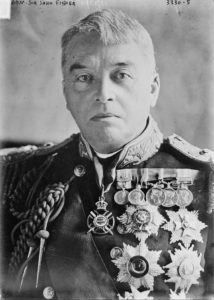 The British admiralty invented the battlecruiser, in 1906 at the same time the Dreadnought was launched. And the man behind the concept was the same: Sir John ‘Jackie’ Fisher, admiral and later first sea lord. His breakthrough ideas and even personal style were all but conventional and not appreciated in conservative British naval circles, but he succeeded to extract the Royal Navy from a slow, sleepy decline based on budget restrictions and complacency.
The British admiralty invented the battlecruiser, in 1906 at the same time the Dreadnought was launched. And the man behind the concept was the same: Sir John ‘Jackie’ Fisher, admiral and later first sea lord. His breakthrough ideas and even personal style were all but conventional and not appreciated in conservative British naval circles, but he succeeded to extract the Royal Navy from a slow, sleepy decline based on budget restrictions and complacency.
Several ideas emerged even before the lessons of the Russo-Japanese war, about an heavily armed armoured cruiser, which could have double the fire power of conventional pre-dreadnoughts, armed with four slow-firing 12-inches and a battery or light 4-in or 4.7-in guns. There was an in-between for heavily protected cruisers armed with fast-firing 10-inches an 8-inches guns. Cuniberti’s design published in 1903 already was a take on this, as he imagined an armoured cruiser with a battery entirely made of 10-inches guns, so a “monocaliber” cruiser. On 21 October 1904, Fisher, who saw this article, pushed through the Board of Admiralty for an armoured cruiser (“HMS Unapproachable”) armed with an all 12-in guns battery. This was accepted in early December 1904, as well as Fisher’s request for a 25.5 knots (47.2 km/h; 29.3 mph) top speed.
He then summoned a “Committee on Designs” to investigate and report on requirements for this project and others. Although independent on paper, it was merely compelled to validate decisions made by the admiralty, but only to address criticism from Fisher or the Board of Admiralty. Fisher indeed appointed himself all of the members of this Committee, and became its President. The meeting of 22 February 1905 resulting in a first sketch and outline design for the new fast armoured cruiser. This proposal was approved by the Board on 16 March, applying a few changes, as reduced anti-torpedo boat armament to 18 12-pdr guns instead of 20.
The design was later named Invincible class, and were still formally known as armoured cruisers until 1911. They were redesignated as battlecruisers by the Admiralty on 24 November 1911, ubut had been completed since 1908-1909 already. Before this, alternative designations were discussed, such as “cruiser-battleship”, “dreadnought cruiser” and lastly “battle-cruiser”. The admiralty wanted to convey the idea this was not an ordinary cruiser, tasked of ordinary cruiser duties such as long range convoy escort, guarding some remote colony, do some commerce raiding or hunting commerce raiders. This type of cruiser was meant to take place in the battle line, alongside battleships, hence this name. The concept was already true for the late armoured cruisers, compensating their lack of protection compared to battleship by a faster-firing battery. Both Germany and Japan saw battlecruisers as more-effective armored cruisers and employed them this way, as a “fast wing” organic to their battle line, a trend already tried by Japanese cruiser in 1904. The US Navy by 1912 it had developed their own battlecruiser doctrine around missions of scouting, screening, and “distantial” operations. So basically they took the very tip of the cruiser typology.
The British battlecruiser program, which defined the short 1904-1922 “battlecruiser age” received more attention from scholars of the Royal Navy and lately naval historians accepted that battlecruisers were really at the very center of Fisher’s “revolution.” Arthur J. Marder’s “From the Dreadnought to Scapa Flow” still shown a Mahanian bias, and dismissed them as such, but this had been superseded notably through Jon Tetsuro Sumida and Nicholas Lambert analysis.
A Veritable Volcano: The Life and Legacy of Admiral Lord Jacky Fisher, Churchill College, University of Cambridge.
It was established this class was to be significantly larger than the last armoured cruiser then in construction, the Minotaur class. Overall they reached 567 ft (173 m) for a beam of 78.5 ft (23.9 m), and a draft of 30 ft (9.1 m), deeply loaded. They also displaced 17,250 long tons standard, and 20,420 long tons fully loaded in battle order, which was 3,000 long tons (3,050 t) more than the Minotaur. For propulsion, VTE was first considered, and then the “Committee on Designs” was persuaded by Fisher to adopt turbines, which took less space than VTE machinery, required fewer boilers and were easier to protect from damage. However direct drive turbines still had issues, the relatively high speed required a small-diameter, fine-pitch propeller with a large blade area, detrimental for manoeuvres at low speed. Parsons alleviated this by giving the possibility of reversing as needed. The rest of this story could be seen in the Invincible class description. See also the study “THE CAVALRY OF THE FLEET:” ORGANIZATION, DOCTRINE, AND BATTLECRUISERS IN THE UNITED STATES AND THE UNITED KINGDOM, 1904-22 by Alexander Peeks in 2015 – Link >
Armaments of battlecruisers
Main armament:
18-in guns/45 Mk.II: 457 mm caliber, Developed for the N3 class battlecruisers
18-in guns/40 Mk.I: 457 mm caliber, Developed for the HMS Furious
15-in/42 Mk.I: 381 mm caliber also shared by the Hood, Renown, Courageous class (and also Revenge and Queen Elisabeth class). Certainly one of the best gun of the allies in WW1 and WW2 combined. Amazing hitting power, large production.
13.5-in/45 Mark V: HMS Tiger, Queen Mary & Lion class. Following the Orion class “super-dreadnoughts” going to 343 mm caliber, the Lion class adopted it.
12-in/45 Mk.X: 1st generation battlecruisers, Invincible and Indefatigable class
Secondary armament:
Contrary to the first dreadnought, which was a pure monocaliber, with just the main battery and anti-torpedo-boats light artillery, the first gen. Battlecruisers and following had a light intermediary armament comprising 4-in guns, like the dreadnought followers, until Iron Duke class, which reintroduced 6-in artillery. Of course it was followed, by HMS Tiger and abandoned, to be retaken on the 1918 G 3 design. In between there has been a return to the 4-in and a test of 5.5 in calibers. The Furious and admiral class tested a two secondary configuration, mixing 5.5-in and 4-in guns while G3 mixed heavier 6-in for antiship combat and 4.7 in for dual purpose.
6-in/45 BL Mk.VII (152 mm): HMS Tiger, G3 design
5.5-in/50 BL Mk.I (140 mm): Furious, Hood
4.7 in/43 AA: G3 design
4-in/44.3 Mk.IX (102 mm): Renown, Courageous class
4-in/50 Mk.VII (102 mm): Indefatigable, Lion class
4-in/45 Mk.II (102 mm): Invincible class
4-in/45 Mk.V AA (102 mm): Admiral class (Hood)
Light armament:
It was not different from battleships of the time, revolving around the classic 3-in guns, with more specialized AA from 1917. Note the G3 was the first using quad 40mm Vickers AA, the famous “pom-pom”.
3-in (76 mm)20 cwt AA: Tiger, Renown, Courageous, Furious.
3-pdr (47 mm): Indefatigable class, Lion class (Tiger: saluting), Courageous, Furious, Hood.
2-pdr (40 mm) AA: G3 design
0.5 cal. Maxim MGs (13 mm): Invincible class
Torpedo armament:
18-in (457 mm): Invincible, Indefatigable class
21-in (533 mm): Lion class, Tiger, Renown, Courageous, Furious (all sub, beam), Hood sub and aw.
24.5-in (622 mm): G3 class
Rivals: Other battlecruisers
The British battlecruisers draw a lot of attention worldwide. All fleets took notice, but they were more or less late to formalize a design. So much so that during the great war, only three countries had battlecruisers: UK, Germany, and Japan. The former had almost twice the number than their immediate rivals, and the Japanese during wartime, thanks to their close alliance signed in 1902, had improved versions of the Tiger class, the Kongo class, also built in Great Britain. The French launched their own studies through Gilles and Durant-Viel in 1912-1914, but none was ordered in time, just as Italy. The USA however were concerned by the Kongo in the Pacific in 1912, and started researching their own type, but the design was postponed, then revived in 1917, but only ordered in the summer of 1920, six very large vessels anticipating the largest designs, armed with 18-in guns. Russia also ventured that way with the Borodino class, never completed. Therefore there was a very “exclusive club” of two countries with battlecruisers, and they learned the hard way how to use them.
The British battlecruisers were of course compared to those of the Kaiserliches Marine. Interesting parallels could be drawn here.
SMS Blücher was arguably an armoured cruiser, and not a battlecruiser, to compare to the Minotaur class.
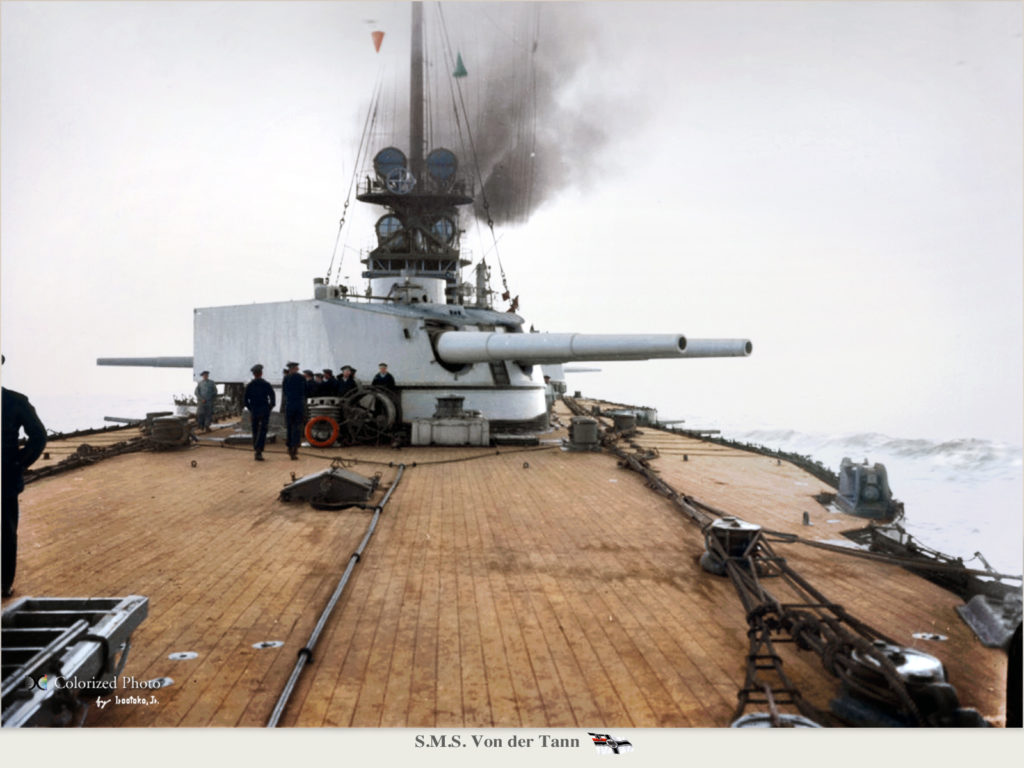
The Von der Tann aft 28 cm turret.
The single SMS Von Der Tann was comparable to the Invincible class, slightly slower, with a comparable protection and the same main broadside artillery. The Moltke class (1911) answered the Indefatigable on a rather positive basis, but they were outmatched by the Lion class, and the contemporary Seydlitz was still up to that point stuck with 11 inches guns, versus 14.3 inches for the British. They only stepped to the 12-in guns on the Derrflinger class when the British built the Tiger, and the Hindenburg was closely derivated. So the Kaiserliches Marine had a distinct inferiority both in numbers and in artillery. However, the Mackensen class (laid down in 1915) wat to compensate for this, with no less than four ships, but still armed with an inferior caliber compared to the Renown class (13.8 in versus 15 in). At last, the Eratz Yorck, three ships to match quantities, laid down in July 1916 for the first, reached the desired 15-in (380 mm) caliber, while the British embarked on a battlecruiser design with only two 18-in guns. This shows there was no close match and frank rivaly. Rather, incremental steps for the Germans, which like for their battleships, always lagged behind in artillery caliber. However, there is a myth about German battlecruisers invincibility (when seeing the number of hits that sustained the most heavily engaged), compared to the rapid explosion of British ships. Armour figures in reality were heavenly matched, but repartition and safety measures made the difference. Speed was also about the same and of little consequence in the frequently encountered heavy weather of the north sea.
HMS Incomparable: Fisher’s “super battlecruiser” (1915)
Fisher, and indefatigable advocate of technology to maintain Britain’s naval superiority, returned to the office of First Sea Lord and oversaw the development of new vessels. He notably had in mind to push the battlecruiser concept to its logical extreme. On one side, he masterminded for an assault on the Baltic coast of Germany three “large light cruisers”. Designed for a relatively shallow draft and mounting large guns, armour was sacrificed, unlike battle line “batlecruisers”. HMS Furious was tailored to carry 18-inch guns forward and one aft. They were way above what the Queen Elizabeth and Revenge-class battleships carried, as well as the Renown-class battlecruisers. Protection wise, they were practically “naked” with at best 3 inches thick armour. In the end, One of these brand new guns was fitted on Furious, aft in a single turret because of weight issues. But the admiralty had other ideas, and it was removed following extensive damage after firing. This was a logical consequence for a ship which was lightly built to save weight. Months after, the admiralty wanted to convert her fully as an aircraft carrier as the “Baltic plan” was dropped entirely.
Fisher meanwhile sketched the HMS Incomparable, seeing it as the logical conclusion of this trend and the pinnacle of the genre. She would have been truly enormous with an intended displacement of 48,000 tons, almost twice the displacement of a Revenge-class battleships (28,000 tons). Only HMS Vanguard in 1946 reached that tonnage. The tonnage was the result of a simple equation.
Fisher wanted to accommodate powerful engines and in speed, reaching the 35 knots mark of possible, while providing a better range. For the artillery, nothing less than 20-inch guns were planned, making even the rare 18 inch guns obsolete. However the projected 20-inch guns needed years of development, even taking a scaling up a 18-in, and they stayed on paper. But the adoption of such gun was proven irrealistic on a ship. Indeed, Monitors already used these 18 inch gun and already ’caused a shower of sheared off rivet heads’ each time their fired. The 35 knots was also way superior to any battlecruiser, even projected at the time or any capital ship for that matter, and was actually faster than destroyers of the time.
But even reaching this standard, Fisher only expected her to last for no more than 10 years; expecting her design to be quickly surpassed by nations of the time. The admiralty took note of the design in 1915 but soon voiced concerned about HMS Incomparable’s dubious tactical value. The great expense of her construction was estimated worth of tw new Renown class, whereas her armour was still weak. If caught by German Dreadnoughts, she would have been in dire straits, even using her speed to escape. The Battle of Jutland in 1916 crippled the reputation of Fisher which saw three of his “splendid cats” destroyed. Soon his ‘large light cruiser’ concept was lost all credit, whereas the admiralty wanted a more pragmatic evolution, towards the ‘fast battleship’. Compromises soon led to a sort of in-between, the Admiral class. The latter was in effect closer to a fast battleship than Fisher’s light battlecruisers, and kept trusted 15-inch guns.
Battlecruisers in action

HMS Lion
Of the 12 battlecruisers Great Britain built, before, and during WWI, only 10 saw action during the great war. Furious had problems with her heavy 18-in guns and soon stopped all firing tests to be soon converted as an hybrid, then full aircraft carrier, whereas Hood, the sole battlecruiser of the Admiral class, post-Jutland generation, was completed after the war. In WW2, after the treaty of washington and moratory on all capital ships, the battlecruiser concept was seen by some as an obsolete concept, and others just as “light fast battleships” that needed modernization and added protection.
British battlecruisers participated in many naval battles and operations during WW1. At Jutland came their ultimate test, seeing them blasted with apparent ease by German fire, and pitted not against their kind, but battleships, a consequence of their use in a battle line. Overall their performance was judged abysmal during this battle, moreover when compared to the punishment taken by German battlecruisers at the same battle. A myth started about the amazing protection the German ships were supposed to have, which was later disproved (when studying the wrecks in Scapa Flow during the interwar). After rediscovering the British hulks of Invincible, Indefatigable and Queen Mary. It seems the culprit layed in the open flash doors, specifically built to prevent an exposition to spread in the powder charge or ammunition magazines. It was the result of an habit by the crew to left them open to reach a higher of fire. But the lessons learned at the time were simply that protection was insufficient. This led to revise the design of the projected Admiral class, of which the first ship, HMS Hood, was precisely laid down at John Brown the day of the famous epic battle. As a result, the Hood would emerge as a much better protected battlecruiser, announcing the trend for “fast battleships”.
So what tactics played British Battlecruisers in WW1 ?
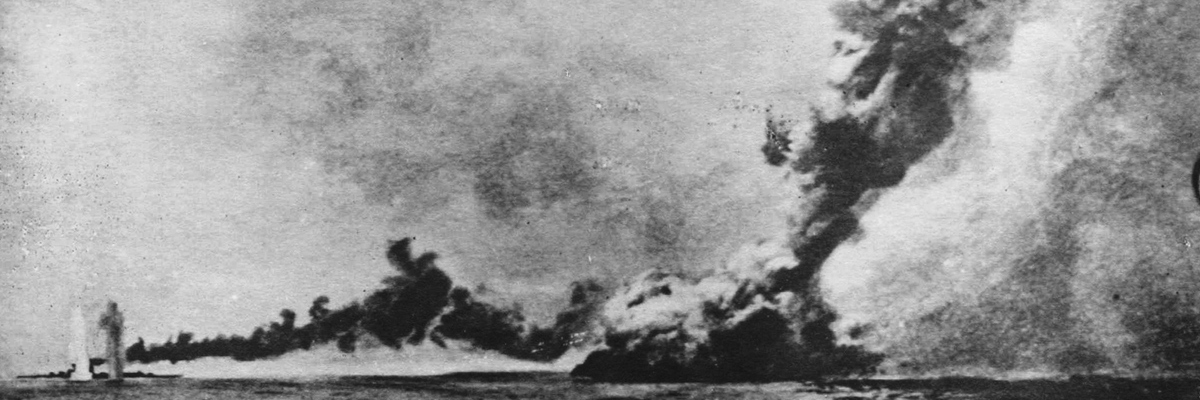
HMS Queen Mary at Jutland
Before Jutland, they were, as planned by Fisher the new “cavalry” at sea, able to catch up an enemy fleet by its speed, which soon appeared vital as the Hochseeflotte commander, Von Tirpitz, ordered Von Hipper, at the head of the German battlecruiser squadron, to deliberately provoke the British by raiding an bombarding coastal cities. The idea, which was pursued all along the early part of the conflict, was to draw the British fleet (especially Beatty’s battlecruiser squadron) to a trap, basically bring them into range of the backup Hochseeflotte’s main battleship line. At Jutland it arguably nearly succeeded as Beatty’s squadron was crippled. The British like the German doctrine was to keep these battlecruisers in the same unit, organic to the fleet at large, and acting as independent “scouts” but able to take part in a battle if needed by taking positions and manoeuvring, thanks to their faster speed, in the best spot for effective action. Note that this conflict was the first in which such class of vessels could be used operationally, therefore the application doctrine was learned and improvized on the fly. In complete contrast, the US Navy’s new ships design was not dominated by a single man, but U.S. Navy’s Mahanian worldview was was redefined and discussed by a “strategic elite” in the Naval War College and General Board. As a result, American battlecruisers were intended for scouting and long-range independent operations, not used for decisive actions, as professed by Mahan.
Projected battlecruisers (1920-21)
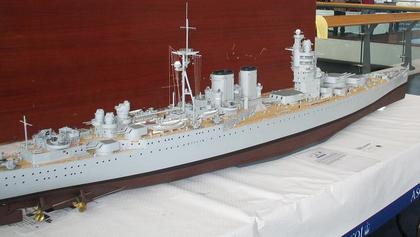
Yard Model of the G3
The last known British design for a battlecruiser was the G3 in 1918, which outmatches in speed, protection and armament even the Ersatz Yorck, and the Admiral class, interrupted by signing of the Washington treaty. This signified that only three battlecruisers, almost named by the treaty, were still available in the 1930s. Only Renown was rebuilt and truly modernized. But were there any plans for interwar battlecruisers ? It was clear that the concept of a very fast and much better protected battlecruiser evolved in a fusion called later the fast battleship.
But in 1920, outside the G3, a serie of designs were studied, which ran in reverse alphabet from K to G.

-Design K2 (June 1920): Basically a battlecruiser version of the battleship L2 design. 875 (wl)/266m x 106/32m x 33.5 ft/10m, displacing 53,100 tons. Powerplant 144,000shp for 30kts. Armed with 4×2 18in (457 mm), 8×2 6in (152 mm), 4×1 4.7in (114 mm) HA 4×10 2pdr (40 mm), two 24.5in TTs (622 mm). Protected by a 12in (305 mm) thick main belt, internally, 25° link to vertical. Deck armour 7-6in thick. The main difference was a much larger machinery than the L2, occupying 250ft of hull length (152 ft on L2). The admiralty found these unsatisfactory design as too large while they needed more protection 33kt rather than 30 knots to match the USN Lexingtons.

-Design K3 (june 1920): Essentially a battlecruiser version of the L3 battleships. It was was about the same size, but displaced less, at 52,00 tons but with the same output, 144,000shp for 30kts. Armament however was larger, nine rather than eight guns (3×3) 18in, the rest was the same. Same armour figures too.

-Design J3 (November 1920): A later design which attempted to replicate the admiralty class with other solutions. A shorter design at 860 (oa) x 104 x 29ft (262 x 31.6 x 8.8 m) displacing 43,100 tons, but with a 151,000shp output, enough for 32kts. Lighter armament for nine (3×3) 15in (381 mm), 6×2 6in (152 mm), 6×1 4.7in HA (114 mm), 4x 2pdr (40 mm) pom-pom mounts, two underwater 24.5in torpedo tubes. It was the only design submitted with an external belt 12in thick and sloped to 25°. It also had a single flat armoured deck, 4in thik (102 mm). Also she was a classic stern design, not the case for its followers. Not juged successful by the admiralty which wanted something bigger than the 15in caliber and more speed, again to match the Lexington, while the armour only protected from 15in rounds (18 in for the Lexingtons) while protection elsewhere was still light.

-I3 design (December 1920): Essentially a battlecruiser version of the M3 battleship design. The I3 was quite large at 925 (oa) x 108 x 33ft (282 x 33 x 10m), displacing 51,750 tons and propelled by a powerplant giving them an output of 180,000shp, for 32.5kts.
Armament was stronger, with three triple 18in gun (nine 457 mm), while the rest was essentially the same. Armour still counted 12 inches belt, but sloped at 12.5° and slightly better deck armour at 7-8 inches. Between the angled downwards internal belt and the ships bottom were installed sealed steel tubes compartimented trapping air in case of a flood and torpedo hit. They also served as a “de-capping” layer for APC shells. They were so large as to be unable to dock at Portsmouth or Rosyth, and in fact were the largest warships ever considered by the Royal Navy at any time (until modern aircraft carriers of the 2000s !). These were essentially a fast M3, but with a different machinery layout as the engine rooms were located behind the boiler rooms, and four shafts. This design was rejected as deemed too large to be practical.

-H3a design (December 1920): The admiralty requested three smaller derivatives of the H3 design. The first was indeed also the smallest of the three. It measured 850 x 105 x 33ft (260 x 32 x 10 m), displacing 52,000 tons and with an output of 180,000shp, at last reaching on paper the desired 33.5kts asked for so long. Armament was much lighter, with just six 18-in guns (in two triple turrets, both at the front), same for the rest. Armour this time went to a radical upgrade, with a 14in thick belt, angled at 12.5 degrees while deck armour rose to 8-9 inches for a total weight for the armour alone of 13,250 tons. Engineers just deleted the aft turret and worked from there.

-H3b design (December 1920): The second design considered was a variant with both turrets raised but one pushed after the bridge, so a midships turret layout. H3b was 500 tons heavier, with 13,600 tons of armour but paid by a slight speed drop at at 33.25kts.

-H3c design (December 1920): Essentially a repeat of H3b, but with lower turrets, both to spare weight and having a better stability. H3b was also 750 tons lighter, and still 12,800 tons of armour and better speed at 33.75kts. These were discussed until the end of the year, and a new design was prepared in January, the culmination of these discussions: The G3.
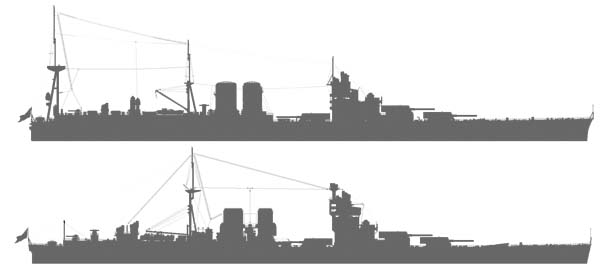
-G3 (February 1921): selected for construction (see above). It had a high metracentric height to remain stable and displaced 48,400 tons for an output of 160,000shp, and 32kts. Basically the powerplant had been squeezed and had some performance penalty, reworked later in water tank testing at Haslar, to just 4% penatly. potentially they would have been less than 30 knots in usual conditions. There was a contingency design prepared, but not officiated, to upgrade it to a 180,000shp plant, with additional sections 25ft long, but only for a 0.5kt improvement.
They were well armed for their size, with three triple 16in turrets (same as nelson, but still not 18-inches) and with eight twin 6in turrets, six single 4.7in HA, and four quadruple or octuple 40 mm pom-pom mounts (10 barelled versions also planned), plus four 3pdr saluting guns and the same two submerged 24.5in torpedo tubes. All weapons had their own fire director. At some point the DNC wanted to delete the torpedo tubes but they were maintained. Provision for two seaplanes was also made but never confirmed with platforms or catapults on B and X turrets. Armour was the best in the serie, 14in belt inclined at 18 degrees, 8-4in decks, 4in machinery space, 8in-9in sloped over the magazines and boiler rooms, 7in over sec. magazine and aft engine room. calculations and some sacrifices compensated an added 1,125 tons by loosing 710 tons. Torpedo protection was calculated to defeat a 750lb warhead.
This design was approved in August 1921, four ships ordered on 26 October but halted by a Cabinet order and cancelled in February 1922 due to the signing of the Washington Treaty. Anyway at the time, Britain was in a financial crisis. Although the design was judged excellent in many aspects, there blast concerns with X turret amidships, which appeared much later with the fitting tests of Nelson and Rodney.

-F2 design (November 1921): Basically a “washington-compatible” version of the G3 design. The cap was now 35,000 tons standard, way below the 48,000-50,000 tonnes worked on until then. The Admiralty ordered two designs to meet this, called F2 and F3, and a third, called O3 battleship, later the Nelson Class. Both F designs were marked by the adoption of a new 15in/50 gun which matched in range the dropped 18-in of previous designs. The armour scheme of O3 was mirrored while a speed of 30kts was kept.
The F2 could be summarized as a “battlecruiser version of the Nelson”. It measured 760 (oa) x 106 x 28ft 6in (231 x 32.3 x 5.6 m) for 35,000 tons as planned. Machinery was of course much smaller and only reached 112,000shp, enabling a top speed of 30kts light. They were armed with three twin 15-in guns (six 381 mm) mixing twin turrets ad single 6-in guns (4×2, 4×1) and four multiple (sextuple probably) 2pdr pom-pom mounts, still two underwater 24.5in torpedo tubes. The internal belt was lighter, back to the old 12in thick scheme, over the machinery spaces, 13in over the magazines but angled at 72.5°, so artificially increasing is thickness. Deck armour was lighter too with 7in over the magazines, 3.25 in over the machinery spaces, 13in barbettes and 16 in turrets faces, 7in sides and back. Total weight of the armour was still 10,210 tons.

-F3 design (November 1921): Variant with a heavier main battery, three triple turrets, but less secondary guns and a lighter armour, lower speed. Dimensions were the same, as the treaty displacement but 96,000shp output and 29kts. They were armed with three more 15-in guns (nine guns in all) and four twin 6in (no additional single 6-in). The armour total was down to 9,970 tons.
Nothing was done for six years, at least until British-led negotiations by Great Britain at Geneva. The 1927 Geneva Conference was an attempt to limit battleships tonnage further down, to 28,500 tons displacement, and the 14in calibre. Basically these were cost-saving measures, but this was rejected by other nations. Would that conference take place after 1929, things would have been completely different. But the admiralty prepared several designs to meet future possible limitations at 28,000 tonnes: A 28,000 Ton Design in November 1926, another in January 1927, a 29,200 Ton Design in June 1927, and the 34,800 ton Design 16A in 1928. All were battleships with a top speed of about 23 knots. No battlecruiser design resulted of these discussions as the additional space needed for machinery would led to impossible compromises.
Read More
J. Gardiner Conway’s all the world’s fighting ships 1906-1921
Brown, David K. (2003). The Grand Fleet: Warship Design and Development 1906–1922 (reprint of the 1999 ed.). London: Caxton Editions.
Burt, R. A. (1993). British Battleships, 1919–1939. London: Arms and Armour Press.
Campbell, John (1985). Naval Weapons of World War II. Annapolis, MD: Naval Institute Press.
Johnston, Ian (2011). Clydebank Battlecruisers: Forgotten Photographs from John Brown’s Shipyard. Barnsley, Yorkshire: Seaforth Publishing.
Campbell, N. J. M. (1977). “Washington’s Cherry Trees, Part 1”. Warship. London: Conway Maritime Press. I (1-3)
Raven, Alan; Roberts, John (1976). British Battleships of World War Two: The Development and Technical History of the Royal Navy’s Battleship and Battlecruisers from 1911 to 1946.
http://www.shipbucket.com/forums/viewtopic.php?t=5705
Nomenclature of WW1 British Battlecruisers
Invincible class Battlecruisers (1907)
Invincible, Indomitable, Infexible
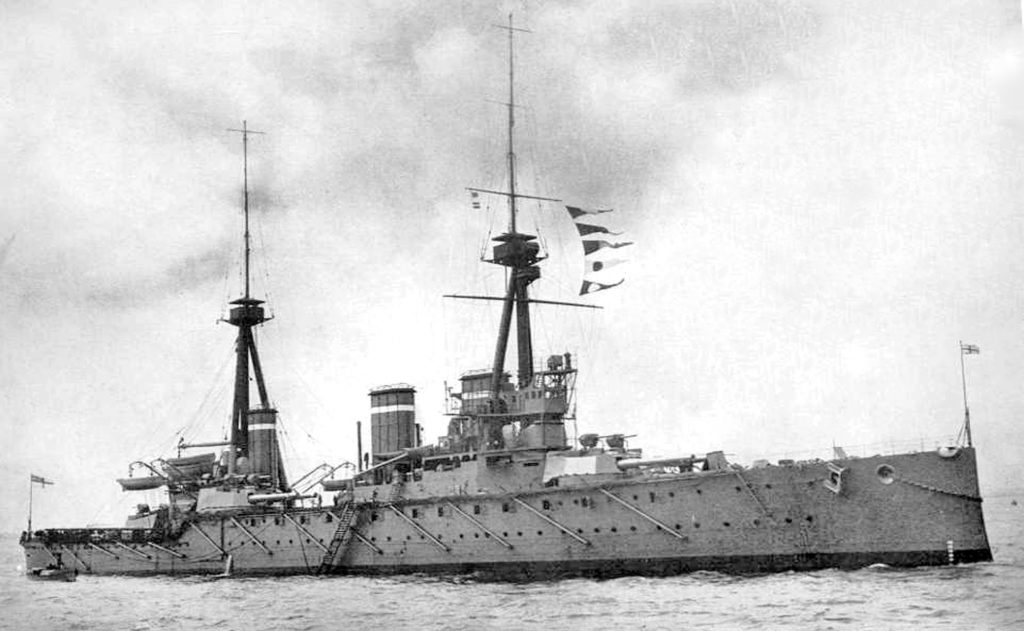
The first battle cruisers: Cruisers, naturally faster than heavy battleships, have always been seen as “scouts” or vanguard vessels, compared to light cavalry – all things considered – on a conventional battlefield. Hadn’t the first single-caliber battleship, the Dreadnought, itself been influenced by the armoured cruisers developed by Cuniberti. In addition, a continuity within the Royal Navy saw each new class of battleship aided by a new class of cruiser-battleship, with the same advances and artillery management, like the Minotaur versus the Nelson. So it couldn’t be otherwise with the new Dreadnoughts.
From the announcement of the HMS Dreadnought’s start-up, discussions went well between Admiral Fisher and the shipyard design offices. The latter, after the demonstration of the Russo-Japanese war, had rallied to his views the rest of the Admiralty. Speed was the deciding factor, he said, and armored cruisers were just too slow. The speed was a much better “active” protection, by protecting the ship from enemy than the passive protection, armor being relevant only against submersibles, torpedo boats and destroyers.
It is on these assumptions that the concept of “battle cruiser” was created, to clearly mark the break and at the same time the continuity with the previous cruiser-battleships. Because indeed, unlike the latter, these new ships would be equipped with the same monocaliber armament as the Dreadnoughts, but trading protection for a higher speed, they had no protection against enemy fire, except for some areas protected by 6-in plating, the standard of light cruisers of the time. Their artillery range on paper protected them from all kind of cruisers which were as fast, and this same speed enabled them to evade battleships, but also to “harass” them, thanks to their greater mobility. The speed as a concept of active protection became successful in many naval staffs around the world, and battle cruisers stayed relevant until their ultimate test and moment of truth, at the Battle of Jutland.
Design
The Three Invincible, started in Fairfield, Clydebank and Elswick from February to April 1906, were launched in early 1907 and completed in June 1908 (Indomitable), October 1908 (Inflexible) and March 1909 (Invincible). But the final plans revealed ships that weren’t light and elongated clones of the Dreadnought, but rather new kind of armored cruisers. Admittedly, they had the same – lightened – turrets as the Dreadnought, but only eight instead of ten main guns. In addition, the central turrets were staggered, an arrangement contemporary of the battleships USS Neptune and Colossus. Theoretically, this provision in echelon allowed a complete broadside of the 8 guns, although in that case their angle of fire was limited, and six in chase and retreat.
The design of these ships took time, as did their construction. They were also 50% more expensive than previous Minotaur-class battleship cruisers, but fulfilled the specifications perfectly and obtained excellent results in their trials. The criticisms against them were later, and specific to the whole category. Confusion was maintained in the admiralties. Armed with large guns, and even in their denomination, they were integrated from the start within the line of battle, with battleships, while their real role was that, classic, of cruisers: To wage war on trade and hunting down cruisers of all sizes. They had never been designed as fast battleships but were used as such.
Their machines were very powerful, matched with no less than 31 B&W or Yarrow boilers. They reached 25.5 knots, 2.5 more than the last armoured cruisers. Some later changes affected them. Successively, all three saw their raised front funnel, canvas cowls protect their light parts on the roofs of the turrets, and in 1914, the removal of their anti-torpedo nets and the addition of fire directors. Later, they were fitted with a 3-in (76 mm) anti-aircraft guns, their upper masts were reduced, and their front upper mast was removed. Aircraft platforms were added to the turrets which received additional armor, over ammunition stores, following the Jutland experience in May 1916.
The Invincible class in action
HMS Invincible
HMS Invincible collided with the submersible C13 in 1913. At the time of the declaration of war, she was in Queenstown, preventing a German sortie. Then he returned to the Humber, took part in the Battle of Heligoland Bay on the 28th, was then detached with the Indomitable to the Falklands, under Commodore Sturdee’s orders, and took part in this second battle of the Falklands in November 1914, avenging the destruction of Sir Cradock’s squadron by sinking Vice-Admiral Von Spee’s battleship cruisers Scharnhorst and Gneisenau, pivots of the German Pacific squadron. After a short overhaul in Gibraltar, the Invincible was detached to Rosyth, forming with his two twins the 3rd Battlecruiser Squadron. In May 1916, further modifications, then shooting exercises at Scapa Flow followed by a change of assignment (the third squadron of battle cruisers), were his last moments before the legendary Battle of Jutland.
Bearing the mark of Rear Admiral Horace Hood, Invincible engaged the German light cruisers Pillau and Wiesbaden, knocking them out, then crossed swords with the battle cruiser Lützow, inflicting her two severe hits. But soon SMS Derfflinger framed her, and she took 5 hits, the last being fatal: It blew up its side turret and caused an explosive fire fuelled by the cordite dust accumulated in the ammunition pit. The fire immediately spread to the nearby charges magazine and a gigantic explosion ensued, breaking her hull in two. She quickly sank, carrying with her nearly all of the crew.
HMS Indomitable
The Indomitable, who interrupted trials to take the Prince of Wales to Montreal, served in the Home Fleet. He was then transferred with the Invincible to the Mediterranean, underwent some modifications in Malta in June 1914. In August, they took part in the hunt for German Goeben and Breslau, escaped from Port Said, then in the bombardments of the forts of the Dardanelles. He was then back in Rosyth, and engaged in January 1915 in the Battle of Dogger Bank, encircling the Blücher with his shots, finally sunk by the Queen Mary. He even managed to destroy a Zeppelin with two hits from his maximum rise 305mm guns! … He towed the heavily damaged HMS Lion to Rosyth. Shortly after, the Indomitable was itself the victim of a fire, quickly subdued, caused by an electrical short-circuit. After a short overhaul, they were detached to the Grand Fleet, and took part in the Battle of Jutland, successively hitting the Derfflinger and Seydlitz and damaging the battleship Pommern. The rest of her career was fairly calm, in the 2nd battle squadron until 1919, when he was placed in reserve. She was BU in 1922.
HMS Inflexible
Inflexible suffered damage during test fire, and then from the explosion of a coal barge. She bore the mark of Sir Edward Seymour during its visit to New York at the end of 1909. In 1911, it collided with the Bellerophon, and repaired, it was then posted in the Mediterranean, bearing the mark of Admiral Milne and serving as Fleet Headquarters. He participated in the hunt for Goeben and Breslau in the hours following the declaration of war, and after an overhaul, was sent to the Falklands, fighting and destroying the Von Spee squadron. In 1915, sent to the Mediterranean, he replaced the Indefatigable, bombarding the forts of the Dardanelles. He suffered blows on Turkish goals, losing two 305mm guns on March 18, and was struck the next day by a mine, forcing him to break off the fight and be towed for repairs to Malta. Back in Rosyth, he fought in the Battle of Jutland, without sustaining damage. Then it was a long inactivity and its participation in the short “Battle of the Isle of May” in February 1918. It was put in reserve in 1920 and demolished two years later.

Technical specifications
Displacement: 17,373 t, 20,080 T FL
Dimensions: 172.8 x 22.1 x 8 m
Propulsion: 4 shafts Parsons turbines, 31 Babcock and Wilcox boilers, 41,000 hp. 25.5 knots
Armor: Belt 150, Battery 180, Barbettes 180, turrets 180, blockhouse 250mm, bridges 65 mm.
Armament: 8 x 12-in (305)(4×2), 16 x 4 in (102mm), 7 Maxim 0.3 in MGs, 4 21-in TTS.
Crew 784
Indefatigable class battlecruisers (1907)
This second class of battle cruisers in the 1908 plan was modelled on that of the Neptune in terms of armament. On the other hand, they resumed the armor configuration of the Invincible, and their faults. The rationale for building these three ships in a short time was also to provide two of these for the Pacific squadron, HMAS Australia and HMNZS New Zealand. They were the subject of some exaggeration from both Sir John Fisher in terms of firepower and Fred T. Jane in his armor review. In fact, they were neither faster nor better armed. The additional length of the hull was only justified to allow a side plating, unlike the Invincible. The first configuration of this ship mentioned a front funnel of the same height as the others, but for obvious reasons of inconvenience caused by the smoke, this one was raised during the tests, and in completion on the two others. The problem was the same with the aft tripod fire control post, and it was dismantled during the war on all three ships.
HMS Indefatigable was put on hold in 1909, launched in 1909 and completed in April 1911 while HMAS Australia was delivered in June 1913 and HMNZS New Zealand in November 1912. The latter received a 76mm AA gun and a 57mm . The other two received a 76 mm AA gun in March 1915. After Jutland, they received a number of modifications, armor plating, new projectors, a new extended fire control post, shortened masts. Their aft stern 533 torpedo tube was also removed. An additional 76mm gun was added to them in 1917, and in 1918 aircraft takeoff platforms on the two central turrets, accommodating a reconnaissance Sopwith Strutter and an escort Camel. In 1919-20, they still received some modifications of DCA.
The Indefatigable in action
HMS Indefatigable was operational within the 1st squadron of battle cruisers, then was sent to the Mediterranean with the 2nd squadron of battle cruisers. He took part in the hunt for the German Souchon squadron at the start of the war, then left for the Aegean. He became Carden’s flagship, then replaced by the Unyielding. He was back in the Grand Fleet in early 1915. He was at the forefront of Beatty’s ships during the Battle of Jutland in May 1916 and suffered several hits from the Von der Tann, including two in the aft turret ammunition bay. The whole hull fell apart aft and the ship quickly sank from the stern. Another salvo detonated the central holds and the ship was literally disintegrated, leaving no chance for its crew.
HMAS Australia was sent to Ausralia where she became the flagship of the RAN. He was mobilized within a large Australian-New Zealand squadron to respond to Von Spee’s incursion into the South Pacific. He took part in the second battle of the Falklands, then after having tracked down the supply vessels of the German squadron, returned to France within the Grand Fleet. He was not present at the Battle of Jutland, as under repair after a collision at sea with his sister-ship, New Zealand in April 1916. He remained the flagship of the 2nd Battle Cruiser Squadron until 1919 before returning to Australia and serving there until 1922 when he was condemned for respecting the restrictive tonnage resulting from the Treaty of Washington. The Australian government therefore decided to scuttle it with a grand ceremony on April 12, 1924 in Sydney Bay. Today it is a large artificial corral reef.
HMS New Zealand, which should definitely have been HMNZS New Zealand, flagship of the small RNZN, was finally taken over after completion by the Royal Navy, to reinforce its strength within the Grand Fleet. He began by touring the world, with many courtesy visits, then left for the Baltic in 1913. He was the Naval Admiral of the 2nd Battalion Cruiser Squadron in August 1914. He fought at Dogger Bank without tangible results, becoming the battlefield Beatty’s flagship when the Lion was disabled. It collided with Australia but was repaired in time to compete in Jutland. He fired 420 shots from his big guns with just 4 shots on goal and took a 280mm impact behind his rear turret. She went on another cruise, taking Admiral Jellicoe around the world in 1919, but was decommissioned and demolished under the Treaty of Washington.
Technical specifications
Displacement: 18,500 t, 22,110 T FL
Dimensions: 179.8 x 24.4 x 8.1 m
Propulsion: 4 shafts Parsons turbines, 32 Babcock and Wilcox boilers, 44,000 hp. 25 knots
Armor: Belt 150, Battery 180, Barbettes 180, turrets 180, blockhouse 250mm, bridges 65 mm.
Armament: 8 x 305 (4×2), 16 x 102, 4 x 47 mm, 3 x 457 mm TTs (uw).
Crew 800
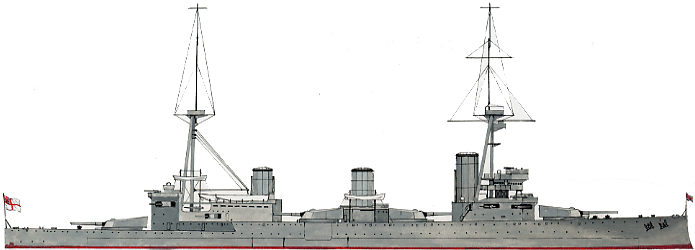
Lion class battlecruisers (1910)
The Lion and the Princess Royal, as well as the Queen Mary launched in 1912, were three ships of a new standard, following the Invincible and Indefatigable. Much larger, they opted for a 13.5 in (343 mm) caliber, that of the Orions, becoming in fact formidable capital ships, faster than battleships, but able to pound them hard while remaining out of range. They perfectly embodied the essence of the battle cruiser concept. The hull was huge, the artillery distributed using a central turret like the Orions, and the power was increased by 150% compared to that of the Orions. Despite a displacement of 29,700 tonnes with a plain load against 25,900, the speed gain was only of the order of 6 knots.
In addition, these ships suffered from fairly significant design faults: The central amidship turret was in itself an error, being inserted with its ammunition and bunker equipment, between the front and rear boilers, the hull was fragile and vibrated, but also very impartially protected in places, even though the press spoke of them as a “capital ship”, of a “fast battleship”, which was perfectly false. In addition, the fire direction post placed very close to the forward boilers was a prison for its servants because the mast which allowed access was made so hot that it was impractical. Despite this, the three Lions, built in Devonport, Vickers and Palmers, launched in 1910, 1911 and 1912, completed in 1912 and 1913 were upon their release the largest warships in the world and were the pride of the Royal Navy.
This pride relayed by the press exaggerated their speed figures reached or exceeded in tests, with peaks at 34 knots while in reality by turning their boilers red (for more than 90,000 hp) this speed remained frozen under the 28.1 knots. These “splendid cats” adored by the Press were in any case despite their youthful defects always naturally at the forefront of the action in 1914-18. They received AA artillery, their mast became tripod and the arc of fire enlarged while the anti-torpedo nets were removed.
The Lion class in action
HMS Lion was part of Rear Admiral Beatty’s 1st Battlecruiser Squadron in 1914. He participated in the Heligoland Bay Action in August 1914, then in the Battle of Dogger Bank in 1915, claiming three shots at goal but conceding three hits on goal with serious consequences: Almost immobilized after its machines stopped (port turbines flooded) It had to be towed to Rosyth by the Indomitable. Repaired, she was then the flagship of the squadron and had its moment of truth in Jutland in 1916. It suffered no less than 13 hits on goal from the Lützow. The battle cruiser escaped certain destruction by the explosion of its bunkers on fire thanks to the guts of the only surviving officer on site, seriously injured and burned, who ordered the intercom the order to drown the bunker where he was. Lion was once again brought with great difficulty to Rosyth and repaired once again. She returned to sea in September. She then made numerous sorties until the armistice under the orders of Rear Admiral Packenham. She was finally disarmed in 1924 following the Treaty of Washington.
HMS Princess Royal was the other spearhead of the 1st Battle Cruiser Squadron in 1914. She fought at Heligoland, was sent to the Far East to intercept Von Spee’s squadron, then to Dogger Bank without recording any damage, This was no longer the case in Jutland where, taken to task by the shots of Derrflinger, Markgraf and Posen, suffered 8 hits and had to drown its bunkers to avoid explosions following the fires. Despite this the ship was operational and remained so until the end of the battle with some of his artillery out of service. Out of Rosyth, she made many more sorties before a disarmament in 1922.
HMS Queen Mary differed from the first two in a few details: She was slightly faster, taller and heavier. Her late completion (August 1913) was due to strikes and social unrest at the sites. Nevertheless, she passed her tests successfully, and joined Beatty’s 1st Squadron for the duration of the war. She took part in Heligoland’s action but not in the Dogger Bank because it was being redesigned at the time. The battle of Jutland was however fatal: After having fired 150 shells and reached the Seydlitz, she was taken to task by the Derrflinger. The latter knocked out one of the two pieces in the third turret. Another shell then fell on the same turret, causing it to explode even as a second made its way into the ammunition bunkers of the front turrets. A terrifying explosion ensued that vaporized the entire front section, including the bridge. The ship slowly sank forward while burning from the inside, with further explosions before sinking with almost all of its crew 38 minutes into the battle.

Technical specifications
Displacement: 26,270 t, 29,690 T. FL
Dimensions: 213.4 x 27 x 8.4 m
Propulsion 4 shafts Parsons turbines, 42 Yarrow boilers, 70,000 hp. 27 knots
Armor: Belt 230, Battery 230, Barbettes 230, turrets 250, blockhouse 250mm, bridges 65mm.
Armament: 8 x 15 in (343mm) (4×2), 16 x 54 in (102mm), 4 x 2-pdr (37mm), 2×21 in TTs (533 mm).
Crew: 997
HMS Tiger (1913)
Despite active lobbying from Sir Lord Fisher, the Admiralty was beginning to doubt the merits of the battle cruiser concept as early as 1911. Instead of launching a new class following the three Lions, the 1912 plan was satisfied with adding a single ship, less expensive than the previous “splendid cats”. The focus was on the improvements to the Queen Mary as a basis for work, and the experience gained in exercises. The positioning of the turrets and superstructures was completely revised, as well as the position and height of the chimneys and the front firing station. It was chosen in particular a powerful secondary armament, in hull battery, and on the central deckhouse, and a large clearance for the aft artillery, according to the recipe applied to the Japanese vessels of the Kongo class, the first of which was under construction at Vickers. Here again, a very high speed was specified, and no less than 85,000 hp were expected to give 28 knots, and over 105,000 by “white-heating” the boilers, which in theory was likely to give 30 knots. In fact, during testing, just 29 knots were reached with 104,000 hp but with daily consumption rising to 1245 tonnes of fuel oil. The smaller hull thus required wonders of invention to find the deficient storage space.
Although not yet having good protection, Tiger was a ship with fine and pleasant lines, original although without descendants. Although she was started after the Kongo, the chief engineer of Vickers drew heavily on the design ideas contained in the Tiger, whose plans had been drawn up early on. In fact, the last of the “splendid cats” – a little less expensive than the others, was launched in December 1913 and completed, then accepted into service after testing, in October 1914. She joined the Grand Fleet in November, naturally versed in the 1st squadron of battle cruisers. Participating in the Dogger Bank, her first important engagement, she suffered 6 blows including a large caliber which disabled his first rear turret, but suffered only 11 dead and 11 wounded.
She was repaired in February 1915 and then took part in its second major engagement in Jutland. In the midst of the fray within David Beatty’s squadron, she fired no less than 303 large caliber shots, but made only three punches to the bit, taking on the other hand 15 heavy impacts, without however compromising his chances of survival too much. This was however a miracle: The ‘Q’ turret (central rear) exploded, as well as a barbette, but the ammunition compartments were spared. Returning to Rosyth, partially on fire and giving band, hms Tiger had 24 dead and 46 wounded. The repairs were not completed until July 1916, and she returned to service with the well-started 1st Squadron, carrying out other sorties. She served in the Atlantic squadron from 1919 to 1922, and after the Treaty of Washington as a gunners training ship, after two years of conversion work, from 1924 to 1929, then replaced the Hood in redesign between 1929 and 1931, and was retired in 1931 to Devonport, demolished in 1932.

Technical specifications
Displacement & Dimensions 28,430 t, 35,710 T PC, 214.6 x 27.6 x 8.7 m
Propulsion 4 shafts Brown-Curtis turbines, 39 B&W boilers, 85,000 hp. and 28 knots max.
Armor: CT 254, belt 230, Casemates 100, barbettes 230, turrets 230, decks 75 mm.
Armament 8 guns x 343, 12 x 152, 2 x 76 AA, 4 x 47 parade, 4 TTs 533 mm SM.
Crew 1121
Courageous class battlecruisers (1915)
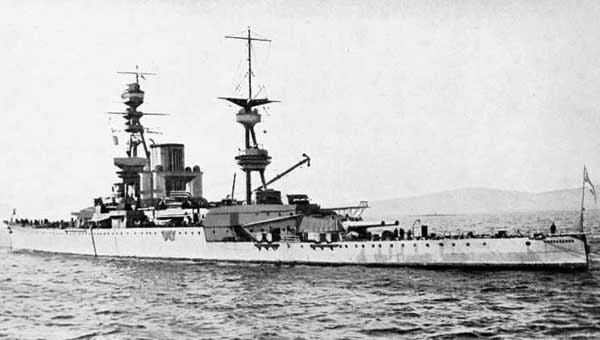
Three large light battle cruisers emerge from Sir Lord Fisher’s fertile brain in 1915 for his plan to land in the Baltic. They had to support the landings with their heavy artillery and flee the units of the Hochseeflotte line. Speed was once again the key. We therefore based ourselves, not on the previous battalion cruisers, drastically reduced, but as extensions of the light cruisers of the time such as the many “class C”. Their armor arrangement, including a superposition of a 51 mm plate on a 25 mm plate, their machines taken from the Calliope class ships and simply doubled, and in the end this arrangement allowed them to provide 90,000 hp with machines light. Compared to previous Renowns, they carried one heavier turret less, but had the same secondary armament, were also large while claiming 8000 tons less and spinning two knots more. Their large, light hull was however subject to vibration and deterioration.
Their active service was long but indecisive: Operations in the Baltic were never done, and they were regarded as great white elephants. The Courageous was converted for a time (April-Nov. 1917) as a minelayer, and on the 17th, he engaged the German light fleet with the Glorious and Furious in the Battle of Heligoland. After the armistice, he was transferred to the training of the gunners and then made to the reserve. Due to the Washington Treaty, it was converted into an aircraft carrier (see navis2gm). The Glorious enjoyed the same career as her sister ship and was not effective during the Battle of Heligoland. She was also converted into an aircraft carrier, and also sunk at the start of World War II.

Technical specifications
Displacement & Dimensions 19,230 t – 22,690 t PC, 239.7 x 24.7x 7.10 m
Propulsion 4 propellers, 4 Parsons turbines, 18 Yarrow water tube boilers, 90,000 hp. and 32 knots max.
Armor Belt 75, Casemate 75, Barbettes 180, Turrets 330, CT 250, decks 40 mm max.
Armament 4 x 381 (2×2), 18 x 102 (6×3), 2 x 76 and 2 x 47 AA, 2 x 533 mm TTs sub.
Crew 2200
Renown class battlecruisers (1916)

The Largest warships of WW1
This was not the last class of English battle cruisers, but without question the Renown class marked a new milestone in the evolution of this controversial concept. In terms of tonnage, these ships were equivalent to or even inferior to that of recent dreadnoughts, but in size, they exceeded anything that had been built to date. These were the largest warships seen at the time, a status they retained until the completion of the Hood in 1920. They also marked a logical evolution towards the 15 inches caliber (381 mm) in parallel, shared with the dreadnoughts of the Revenge and Queen Elisabeth classes. While the Admiralty did not want to hear from other battle cruisers, claiming that HMS Tiger was the last, Lord Fisher’s return in October 1914 as the first Sea Lord called this positioning into question. As expected, the latter spared no effort in requesting the construction of two new ships of this type, capitalizing on victories won by the ships of the Invincible class in the Falklands against Von Spee.
Design development
He was told that these complex ships would not be finished until the end of the war, especially since the Admiralty’s priority was to complete its dreadnoughts and ensure mass production of destroyers. The latter affirmed that it was possible to rationalize production in order to achieve shorter study times and rapid construction. He even hoped for a commissioning at the beginning of 1916. To save time he proposed to recover the sheets and materials engaged in the manufacture of the two Revenge class dreadnoughts bearing the same name, the latter being literally cannibalized and their 381 mm turrets. As again speed was to be the determining factor, Fisher was counting on 32 knots, and to establish it, he discounted new, lighter machines with thin-tube boilers and lighter turbines, but the deadlines meant that we fell back on the adoption of Tiger machines, with four additional boilers fitted into the available space. Last but not least the protection was once again sacrificed, taking up the scheme adopted on the two Invincibles – (Jutland had not yet taken place, and Fisher remained true to his credo, speed is the best protection). In fact, when leaving the yards, these ships whose weight had increased during construction, could only reach the 32 specified knots by forcing their boilers well beyond 120,000 hp, at the cost of a monster consumption of fuel oil. Their normal speed was 30 knots for 112,000 hp, which was already exceptional in itself, and much better than the German SMS Hindenburg (on the contrary much better protected). She remained the record for ships of the line until the rapid arrival of the light battle cruisers Furious and Courageous (32 knots) and of course the Hood (31 knots).
Design
From the start, the hull was equipped with light protective bulges running over the entire belt. Finally, we adopted secondary parts of a light caliber, returning to the solution of the previous buildings, but instead of barbettes, we chose to raise them and group them in simple or triple hides under masks. This triple configuration for five of these carriages was also a strangeness that was not the happiest: The three pieces of each group were independent and alone required more than 10 men for their operation, which in total represented 32 servants. , in the confined space of the armor mask. The complexity of the loading system was also criticized. Although the firing arc of this artillery was in theory excellent, better than the barbettes hampered in heavy weather, their low caliber made them ineffective. This concept turned out to be mediocre in the end and was never taken up again. These two ships were started at Fairfield and J. Brown on January 25, 1915, launched in January and March 1916, and completed in August and September 1916, with the Repulse preceding the Renown. This build had indeed taken a year and 8-9 months, more than expected, but less than the Tiger (two years and four months).
The Renown and repusle in action
When they entered service with the Grand Fleet, the Battle of Jutland had just ended and the battle cruisers had lost all credibility. The turmoil caused by these losses was such that some in the government purely and simply proposed to put these units in reserve. The admiralty, when calm was restored, decided by the voice of John Jellicoe to take over these two buildings and to add 500 tons of armor to them above mainly the ammunition bunkers and the rudder room and steering systems. . Their front chimneys had been raised in November 1916 because of the inconvenience caused by the smoke on the gangway.
The solution was taken up soon after on the Repulse, then adopted by all other recent line ships of the Royal Navy. During 1918, new modifications were used, installation of deflectors, installation of new searchlights in armored towers, while the structure of the long hull, too lightly built to withstand the powerful planks of its six heavy guns, was reinforced, and the rebuilt fire direction post. Protection still remaining problematic, it was decided to reinforce the Repulse with the armor removed from the ex-battleship Cochrane transformed into an aircraft carrier. At the end of 1918, the Renown for its part had to wait for the availability of new armor, received only in 1923-26. Their careers during the great war were insignificant, in part because the admiralty was simply afraid of exposing them to enemy fire. As late as 1918, some vital parts of the ship could be penetrated by 152 mm projectiles. While waiting, the Renown hosted the Prince of Wales during his Asian and Australian tour.
Interwar and WW2
These two ships were once again modernized, receiving a modern AA (with the removal of their 102 mm parts) and new fire direction systems. But only Renown benefited from a total overhaul, coupled with a three-year reconstruction from 1936 to 1939. The Repulse was to be rebuilt in the same way, although the war prevented it. It joined the Singapore squadron with the Prince of Wales and was sunk in December 1941 by the Japanese air force. The Renown for its part resumed service on September 2, 1939 in the escort of aircraft carriers, totally unrecognizable, and with much more armor this time, its tonnage reaching 36,000 tons. His career during World War II was much richer and it was finally demolished in 1948, after thirty-two years of loyal service to the crown.

Technical specifications
Displacement: 27,600 t, 30,800 T FL
Dimensions: 242 x 27.4 x 7.8 m
Propulsion: 4 shaft Brown-Curtis turbines, 32 B&W boilers, 112,000 hp. 30 knots
Armor: Belt 150, citadel 100, barbettes 180, turrets 280, blockhouse 250mm, bridges 75 mm.
Armament: 6 pieces of 381 (3×2), 17 of 102 (5×3, 3×1), 2 of 76 AA, 4 of 47, 2 TLT of 533mm (SM).
Crew: 950
Admiral class battlecruisers (1917)
Genesis of the best British battlecruiser
HMS Hood is exceptional in more than one way: It was the last British battle cruiser and one of the last in service in the world (the Japanese ships of the Kongo class had seen their protection so reinforced that they were classified as “fast battleships”.). He was above all the steel ambassador of the entire Royal Navy, his pride, like that of the country. She sailed on all seas, called in all ports, and proudly displayed the flag there, during a peaceful career that lasted from 1921 to 1941. She was finally the most powerful warship in the world when it was launched and remained such until those dreadful days of May 1941, at least in the minds of the average citizen reading the newspapers in metropolitan France. A symbol therefore. But the aura of a symbolism cannot protect an outdated concept. This is what the hood did, bitterly and violently, the painful demonstration. His other share of fame is due to his legendary (but short) artillery duel with the new most powerful warship in the world, bête noire of the British and in particular of Winston Churchill: The battleship Bismarck.
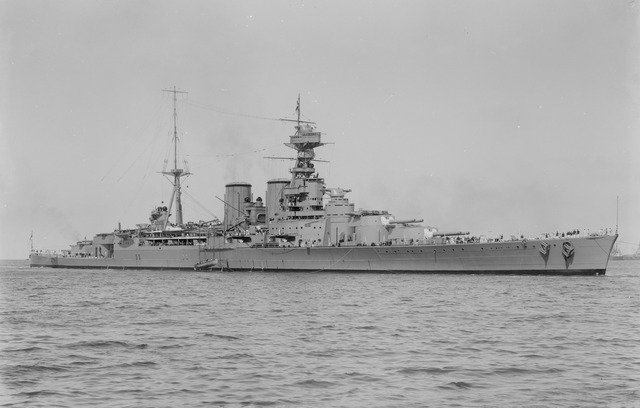
Design and construction
Ordered during the war, before the Battle of Jutland (March 1916), and her keel laid in September 1916, HMS Hood was launched at John Brown on August 22, 1918, but completed after the war, to be accepted into active service on May 15 1920. Compared to previous Repulse, it was a perfect example of the “always more” that prevailed in the admiralty of the time, a race which the Treaty of Washington (1922) ended. She closed at the same time the cancellation of the series, the 4 other sister ships of the Hood, which would have been accepted in service around 1922-24. The Hoods were 33 meters longer, 4 wider, and heavier by almost 10,000 tons, with two additional 380mm pieces. It was therefore de facto the most powerful warship ever built in the world. It remained so until the end of the 1930s. But she was a battle cruiser, and by the will of her parents, notably John Jellicoe and David Beatty, her protection remained relatively weak, athough weaker than prevous ships. However, this type of ship could cross swords with a battleship – from afar, using her firing range. In no way was she ready to fight the Bismarck which was from a whole different generation.
Hood’s career, interwar to WW2
Hood, however, benefited from some concessions to progress, notably a more efficient AA consisting of 40 mm Bofors. However, her fire control was obsolete, like most of its detection and ranging equipment. The “great overhaul” was to take place between the end of 1939 and mid-1941, but the war put an end to this attempt. The Hood was requisitioned urgently, we could not do without. The Hood therefore began a series of interdiction patrols for the German fleet between Iceland and the Norwegian coast. Then she joined the H force in the Mediterranean and took part in Operation Catapult in August 1940 against the French fleet stationed at Mers-el-Kébir.
Back in Scapa for he remained stationed there to intervene in the event of a German invasion in the English Channel (operation “Sea lion”). She was later joined by the Prince of Wales. The threat of an invasion was temporarily repelled with the success of the Battle of Britain, but a new threat began to emerge. In May 1941, it took shape. The Bismarck accompanied by Prinz Eugen attempted an exit in the Atlantic. They were however intercepted by the Hood group, a priori on paper a definite advantage, but as much the Hood’s protection and fire control were obsolete, the Prince of Wales was too recent and not yet fully operational. But Churchill’s order was clear: “sink the bismarck”. The engagement was brief for the Hood, she opened fire at a distance of 16,500 meters. The Bismarck’s first salvo was too short, but the second hit the nail on the head. All the sailors of the Prince of Wales saw this astonishing sight, of a spray of fire larger than the battlecruiser itself, shoot out at the aft mast as the hull lifted and buckled under the enormous pressure. Everyone on board understood it: One of the shells had hit the ammunition bay. The ship, cut in half and on fire, sank very quickly, carrying almost all of her crew. There were three survivors.
In 2001, the wreck of HMS Hood was rediscovered, which was the subject of a BBC report. However, a close examination of the location where the explosion had started did not resolve the riddle of the exact cause of the explosion. Indeed, the descriptions and drawings made of the explosion put their finger on a problem: It started far from the rear ammunition compartment. There was hardly anything there that could provoke it, or at least not on this scale. To date, hypotheses are rife but the truth still escapes specialists.

hms hood in 1941
Specifications (1920)
Displacement: 42,670 t. standard -45,200 t. Full load
Dimensions: 262.20 m long, 31.7 m wide, 8.7 m draft (full load).
Propulsion: 4 propellers, 4 Brown-Curtis turbines, 24 Yarrow boilers, 120,000 hp. Maximum speed 31 knots, RA 8000 nautical at 12 knots.
Armor: 300 mm belt, 100 mm bridges, 152 mm rangefinders, 380 mm turrets, 130 mm central reduction, 280 mm blockhouse.
Armament: 8 pieces of 381 mm (4×2), 14 pieces of 102 mm (7×2) DP, 8 of 40 mm AA (2×8), 1 rocket launcher.
Crew: 1477


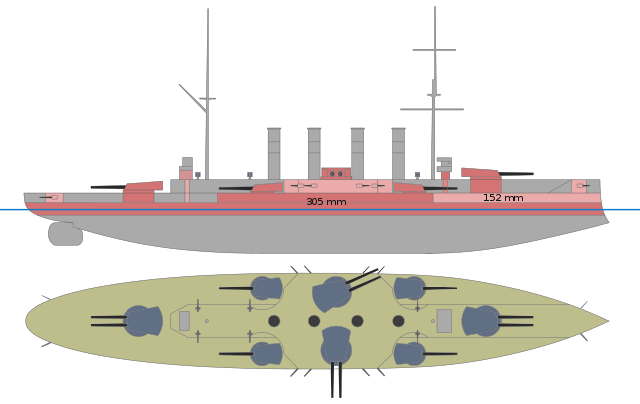
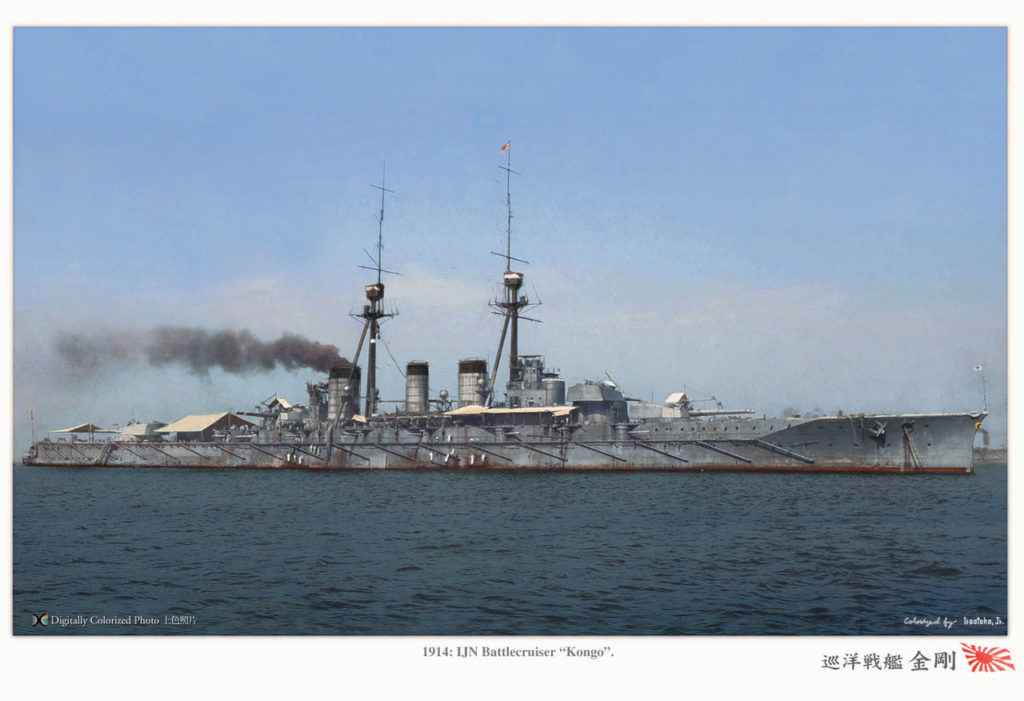
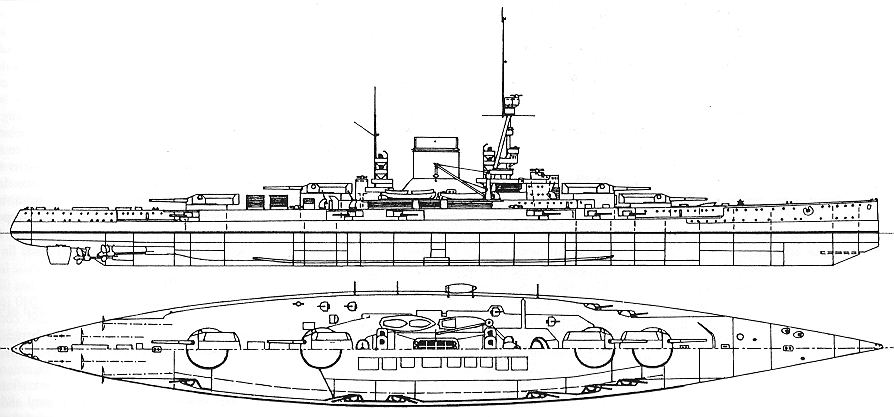
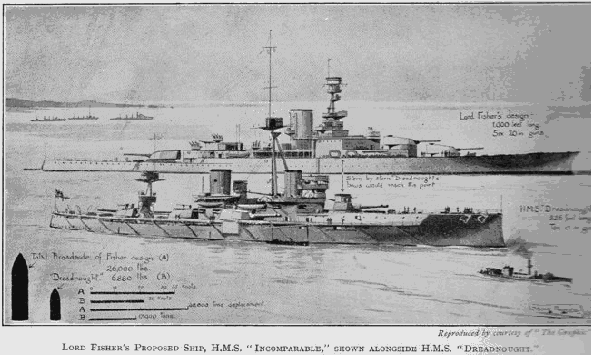

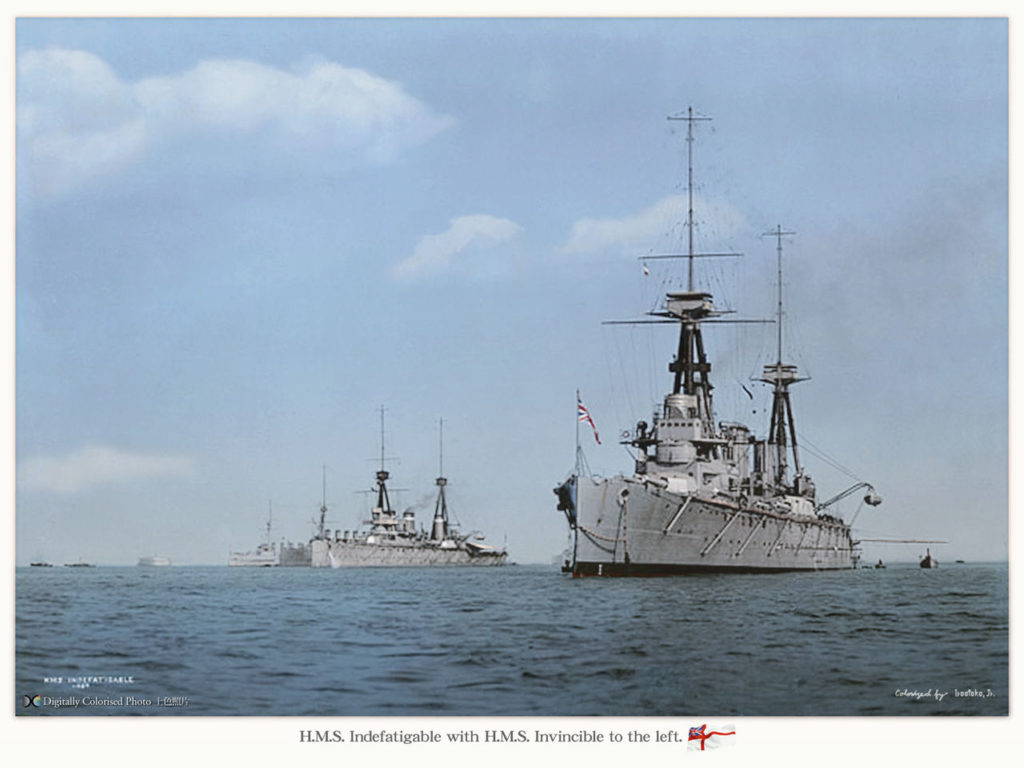
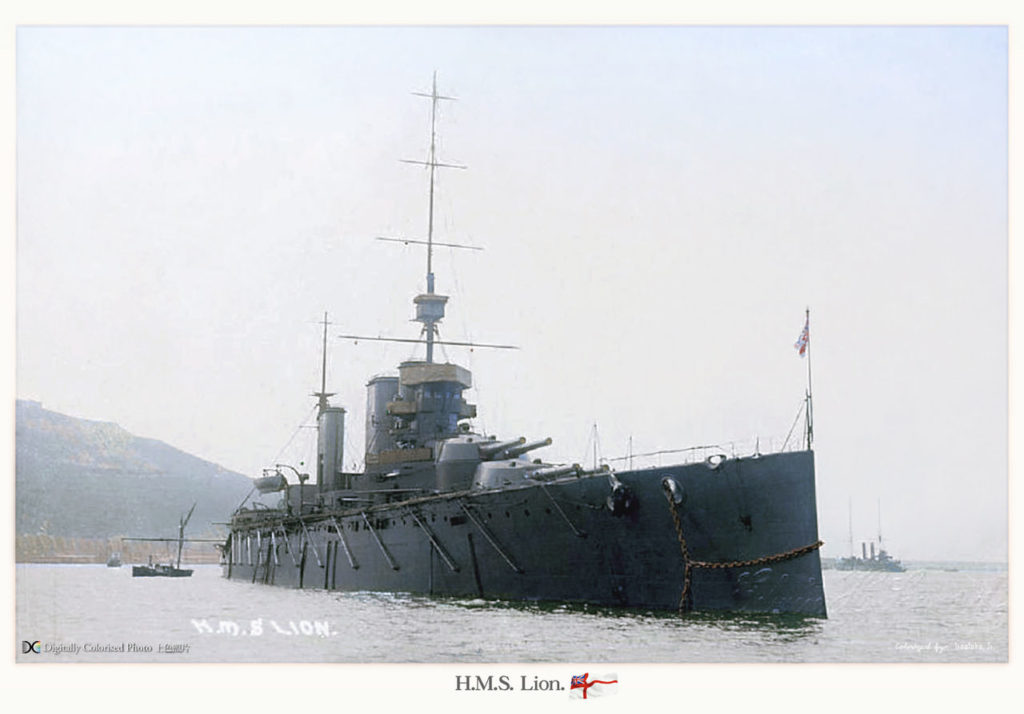
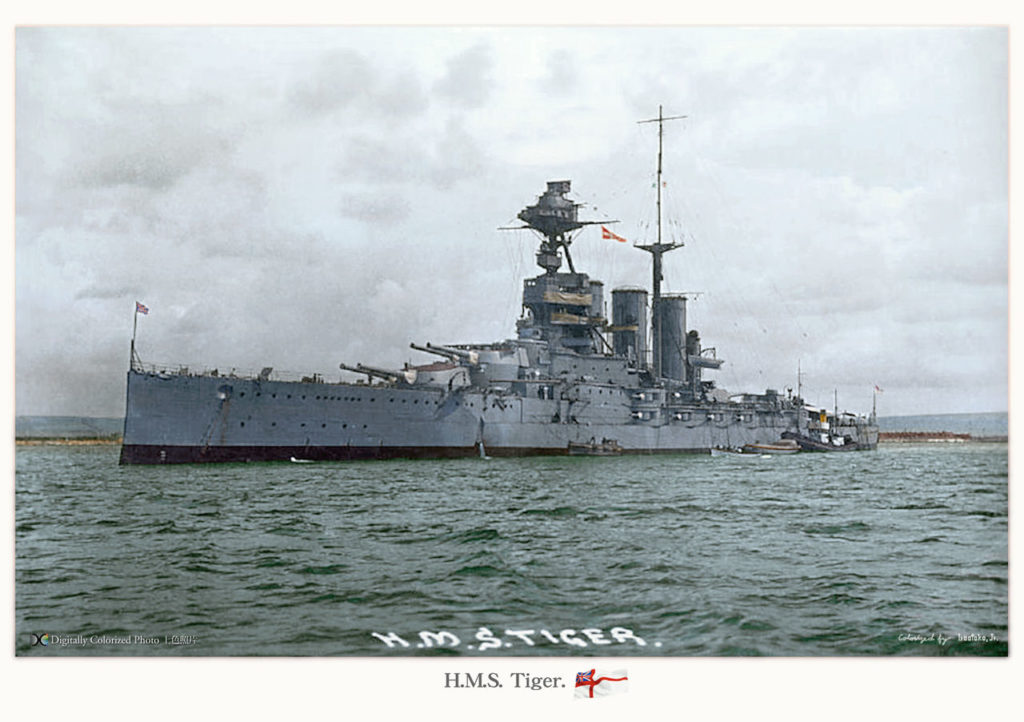
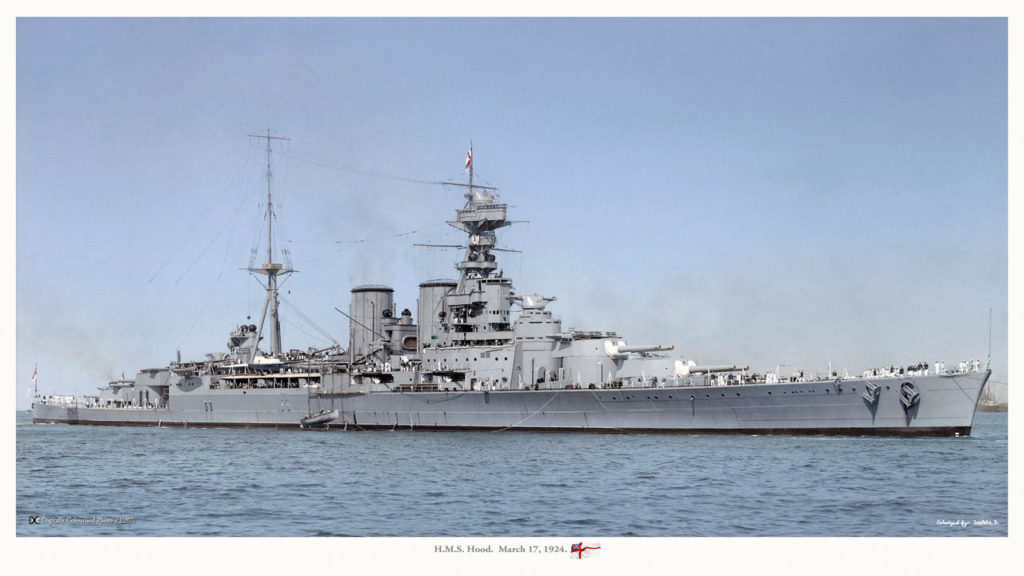
 Latest Facebook Entry -
Latest Facebook Entry -  X(Tweeter) Naval Encyclopedia's deck archive
X(Tweeter) Naval Encyclopedia's deck archive Instagram (@navalencyc)
Instagram (@navalencyc)





 French Navy
French Navy Royal Navy
Royal Navy Russian Navy
Russian Navy Armada Espanola
Armada Espanola Austrian Navy
Austrian Navy K.u.K. Kriegsmarine
K.u.K. Kriegsmarine Dansk Marine
Dansk Marine Nautiko Hellenon
Nautiko Hellenon Koninklije Marine 1870
Koninklije Marine 1870 Marinha do Brasil
Marinha do Brasil Osmanlı Donanması
Osmanlı Donanması Marina Do Peru
Marina Do Peru Marinha do Portugal
Marinha do Portugal Regia Marina 1870
Regia Marina 1870 Nihhon Kaigun 1870
Nihhon Kaigun 1870 Preußische Marine 1870
Preußische Marine 1870 Russkiy Flot 1870
Russkiy Flot 1870 Svenska marinen
Svenska marinen Søværnet
Søværnet Union Navy
Union Navy Confederate Navy
Confederate Navy Armada de Argentina
Armada de Argentina Imperial Chinese Navy
Imperial Chinese Navy Marinha do Portugal
Marinha do Portugal Mexico
Mexico Kaiserliche Marine
Kaiserliche Marine 1898 US Navy
1898 US Navy Sovietskiy Flot
Sovietskiy Flot Royal Canadian Navy
Royal Canadian Navy Royal Australian Navy
Royal Australian Navy RNZN Fleet
RNZN Fleet Chinese Navy 1937
Chinese Navy 1937 Kriegsmarine
Kriegsmarine Chilean Navy
Chilean Navy Danish Navy
Danish Navy Finnish Navy
Finnish Navy Hellenic Navy
Hellenic Navy Polish Navy
Polish Navy Romanian Navy
Romanian Navy Turkish Navy
Turkish Navy Royal Yugoslav Navy
Royal Yugoslav Navy Royal Thai Navy
Royal Thai Navy Minor Navies
Minor Navies Albania
Albania Austria
Austria Belgium
Belgium Columbia
Columbia Costa Rica
Costa Rica Cuba
Cuba Czechoslovakia
Czechoslovakia Dominican Republic
Dominican Republic Haiti
Haiti Hungary
Hungary Honduras
Honduras Estonia
Estonia Iceland
Iceland Eire
Eire Equador
Equador Iran
Iran Iraq
Iraq Latvia
Latvia Liberia
Liberia Lithuania
Lithuania Mandchukuo
Mandchukuo Morocco
Morocco Nicaragua
Nicaragua Persia
Persia San Salvador
San Salvador Sarawak
Sarawak Uruguay
Uruguay Venezuela
Venezuela Zanzibar
Zanzibar Warsaw Pact Navies
Warsaw Pact Navies Bulgaria
Bulgaria Hungary
Hungary

 Bundesmarine
Bundesmarine Dutch Navy
Dutch Navy Hellenic Navy
Hellenic Navy Marina Militare
Marina Militare Yugoslav Navy
Yugoslav Navy Chinese Navy
Chinese Navy Indian Navy
Indian Navy Indonesian Navy
Indonesian Navy JMSDF
JMSDF North Korean Navy
North Korean Navy Pakistani Navy
Pakistani Navy Philippines Navy
Philippines Navy ROKN
ROKN Rep. of Singapore Navy
Rep. of Singapore Navy Taiwanese Navy
Taiwanese Navy IDF Navy
IDF Navy Saudi Navy
Saudi Navy Royal New Zealand Navy
Royal New Zealand Navy Egyptian Navy
Egyptian Navy South African Navy
South African Navy






























 Ukrainian Navy
Ukrainian Navy dbodesign
dbodesign